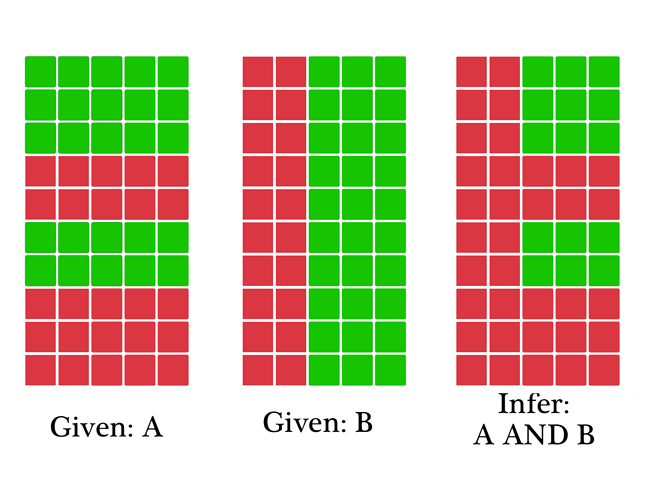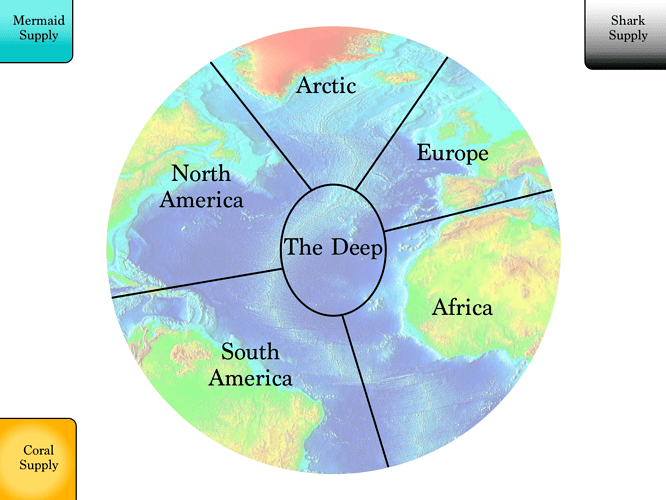Originally published at: http://statelyplay.com/2016/12/07/kelseys-terrible-game-ideas/
I saw the recent announcement of the release of Kathy Rain, and found myself reflecting on how, despite my satisfaction with mystery novels and movies, mystery games have long disappointed me. Largely, it’s because such games rarely give you any incentive to develop hypotheses–sometimes there’s an element of memory or exhaustive search, but mostly, it’s stuff like “Detective Mode” from the Arkham games–you can’t do anything until you see the highlighted clue and press x on it, then the next clue is unlocked. I started thinking about how to do that better, and it occurred to me that I write for a gaming website, so I have a forum to express my terrible ideas to an audience! Here are two.
Some day I’ll learn to use my powers for good, but it is not this day.
The Gerrymandering Game
Some time ago, I tried to come up with a better way to teach formal logic to middle- and high-school kids. It used to be part of New York State’s math curriculum, and I’ve taught it to kids that age before, so there’s no developmental bar, it just got left out of Common Core. But, if there were a more fun way to help kids get a handle on what logical formulas mean, I think it would help a lot to make the argument for bringing it back (and, perhaps foolishly, I hope that this would make it easier to teach children how not to imitate most internet comment boards).
[caption id=“attachment_397” align=“aligncenter” width=“1418”]
Credit to the Wikimedia foundation for this image.[/caption]Though my initial plan was just as boring as the usual exercises, I have hope for this one. The idea would be to create states with some manageable number of nodes (perhaps 100), and assign each of these nodes to agree or disagree with some primitive logical statements (A, B, C, etc.). You would then be given a hypothetical party whose platform was some composite sentence, say (A AND B) IF AND ONLY IF C. You’re given individual maps of the primitives, and must infer from them which nodes agree with the platform, and then draw districts such that your party gets a majority in as many districts as possible. I would particularly enjoy having actual algorithms which have been proposed to reduce gerrymandering added as challenges. For example, on a particular batch of levels you might only be able to draw contiguous districts, or avoid concavity, or draw only horizontal and vertical lines. We might even have implementations of the shortest splitline algorithm, or procedures which are in use in some places today.
[caption id=“attachment_402” align=“aligncenter” width=“1418”]
Once you’ve inferred where voters agree with A AND B, you still need to draw your districts.[/caption]My First COIN
GMT’s COunter INsurgency series is very highly regarded, but I’ve only played Liberty or Death, and it’s going to be beyond my children for years. I understand Cuba Libre is more approachable (and perhaps of particularly timely interest, with Netflix’s release of The Cuba Libre Story and the recent death of Fidel Castro), I wanted something with both a theme and mechanics which strip this basic structure down to essentials.
[caption id=“attachment_508” align=“aligncenter” width=“1728”]
I should probably tweak the color scheme.[/caption]My first attempt is set in a fantasy version of the Atlantic Ocean. The four factions are the Coral Minds, Shark-men, Mermaids, and the Deep Ones, a race of manipulative demons sealed away at the bottom of the ocean. To simplify things, each faction has one Action, one Bonus, and a unique win condition (for those familiar with LoD, there are a variety of each available to its factions). Each turn one card from the event deck gives players an event option, with the next turn’s event revealed atop the deck. In my first draft, I had the order of play determined by the event card, which is helpful for balancing, but I think probably not worth the confusion to younger minds. Better would be to have a static order, and balance the cards with their effects.
Only two players may play each turn, but which option the first player chooses determines what’s available for the second, and no one can play in consecutive turns. The options are 1) Action and Bonus, which lets the next player do the Event, Action, or Bonus, 2) Action only, which lets the next player only do their Bonus, and 3) Event, which allows an Action and Bonus to the next player. Alternatively, a player may skip, which keeps them available to play next turn, passes their options to the next player, and allows them to add a single unit from supply to the board (as the Deep Ones have no units, they may take a coral, which they spend like currency, from supply and add it to The Deep). This is all quite similar to the main COIN games, as I understand the series, and was the principle element I wanted to make familiar to younger players. Battles are simple: flip a coin for each mermaid and shark. Mermaid heads remove Sharks to supply, Shark heads alternate removing first a Coral to the Deep, then a Mermaid to supply.
We playtested it once, and the factions did play very differently. Mermaids win when the event deck is exhausted, so they’re just playing for time. Their action replaces one Shark with a Mermaid (magic is weird), and their bonus just shifts all Mermaids one region clockwise with the currents. The Shark-men win if all Sharks are on the board, but their action is to move every shark to a neighboring region declare one battle (which keeps the Coral and Mermaid populations in check, but also usually sets them back on their win condition). Fortunately, their Bonus is the sexiest option: they place a Shark anywhere there are two Sharks. The Coral Minds win when all regions except the Arctic have at least three Coral, which their Action directly serves: place a Coral in any non-Arctic region or two Coral in a region which already has Coral. Their bonus represents the beneficial effects of deeply thinking and taking indirect action: they can replace the on-deck card with a random card from the discard pile. Finally, the Deep Ones are trying to spread a blight to every region. Their action is to start a battle, which helps them destroy Coral and keep the Sharks from overpopulating, but their bonus their central dynamic: they may spend five Coral from the Deep to remove everything in one area without a blight token to supply, and then place a blight token there.
I’ll post all the card text in a comment, but I’ll have to rework them if I do get rid of the variable player order on the cards, anyway, as some of the cards are deliberately overpowered for the last player. But the dynamics of the game seem basically sound already–the Deep Ones want to keep the Shark population large enough to send them enough Coral to blight the world before the deck runs out, which requires that they risk a Shark victory. The Sharks want to choose their battles, but their need to move constantly means this requires delicate planning. The Coral Minds are in an uncomfortable symbiotic relationship with the Mermaids, who are their principal way to keep Sharks from overpopulating and destroying all the Coral, but the only way they have to defend the Mermaids involves backsliding on their win condition. And the Mermaids are constantly balancing everything.
As you now know, my game ideas are bad enough that I’ve no need to hold tightly to my intellectual property. If you have any equally terrible ideas, share them in the forum, and we can all express our appreciation for the professionals. I’m going to see if I can imagine a decent game based on home improvement catastrophes and how to fix them (the idea which Kathy Rain kicked off, because these are the sorts of mysteries I face in real life) or the eleven American nations.



